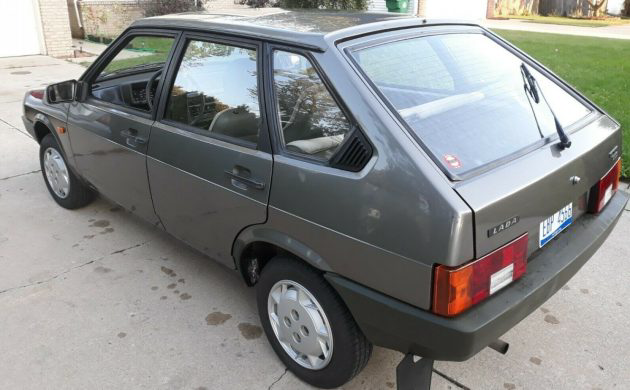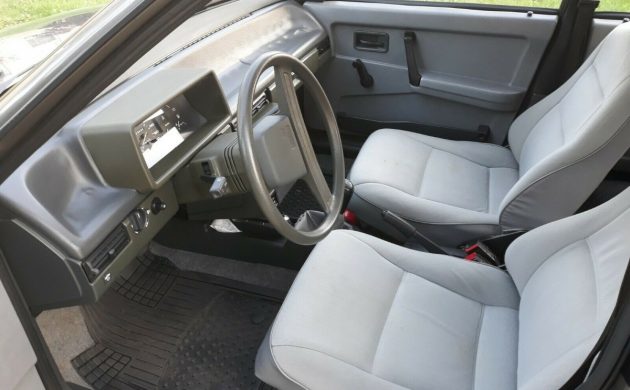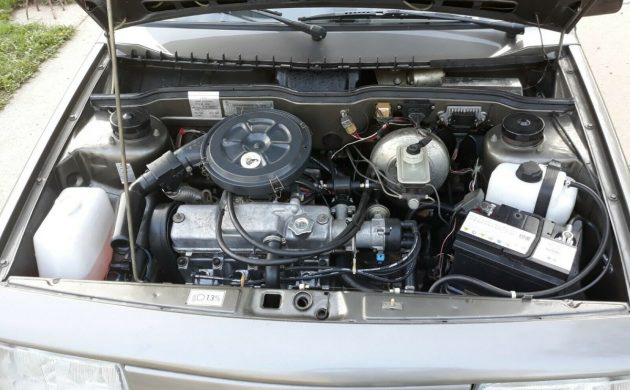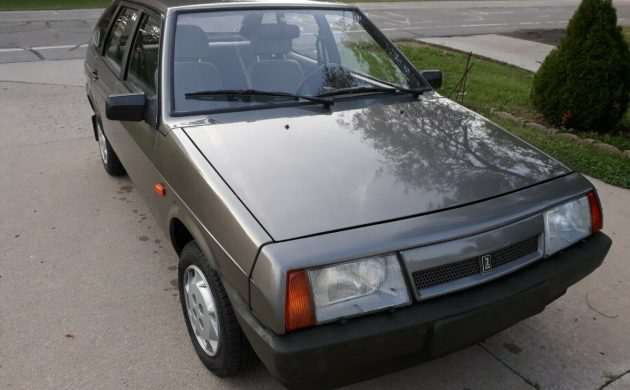Would You Drive It? 1991 Lada Samara 1500S
When it comes to model cycles, there was a world of difference between the philosophies of Western manufacturers and those of Communist countries. Where Western manufacturers generally approach these cycles on a 3-to-5 year basis, for countries such as the former Soviet Union, these cycles could easily be measured in decades. The Lada Samara is a perfect example of his philosophy, as it remained in production in mildly updated form from 1984 until 2013. This 1991 Samara 1500S is a clean and tidy looking example, which is located in Garden City, Michigan. It has been listed for sale here on eBay with a BIN of $8,500, but there is the option to make an offer.
The 1500S rolled off the Lada production line in Tolyatti, Russia, in 1991. Lada had managed to open some export markets to the UK, Australia, and some European countries by this point in time, so this one found itself being sold in Belgium. It remained with its original owner until it was eventually imported into the USA. The original elderly owner used the car on a very limited basis, and as a result, it has remained quite nicely preserved. The Gray Metallic paint has a nice depth of shine to it, and the panels appear to be very straight. The Samara was not a car that was particularly susceptible to rust issues, and while the owner makes no mention of any problems, there are certainly none visible on the car. The external badges and plastic trim look to be in good condition, as does all of the glass. One thing that you will notice is the size and consistency of the panel gaps on this car. They are quite large and varied, but this is not something that is unusual with cars from Lada. As well as extended model cycles, Lada was renowned for their ability to push their stamping presses and dies way beyond what would be considered to be normal by Western standards. As a result, the dies became quite worn, and inconsistent panel quality was the norm. Of course, this made aligning panels quite difficult, so the workers could only do their best with what they had to work with. Personally, I think that it just adds to the character of the vehicle. It also helps you to appreciate the fit and finish of local cars from this era.
Behold the sea of gray plastic which is a Samara interior. In general terms, the interior of the Samara appears to be in good condition, but it is incredible to compare the quality of the trim materials of this era with those offered by manufacturers such as Toyota, Ford, or General Motors. The plastics in the Lada almost always look hard and brittle, while the color match between plastic pieces such as the dash, console, and ashtray are quite poor. I did notice that the vinyl on the dash pad is starting to lift away from the dash itself, which is a very common occurrence. It is possible to have the vinyl removed and reattached, but this can be a fairly time-consuming and expensive process. Of course, a replacement could also be an option, and I managed to locate a company called Lada Power that stocks NOS pads for US$110. As an added bonus, they are willing to ship these items worldwide. Luxury appointments were not a high priority with the Samara, and it doesn’t even score so much as a radio. Try finding another 1991 passenger car that is as austere as this. It really does help you to appreciate just how spoiled we were in the West at this point in time.
Under the hood of the Samara, we find a 1,499cc 4-cylinder engine, which sends its 75hp to the front wheels via a 5-speed manual transmission. Mechanical sophistication isn’t high on the agenda, so while the owner finds themselves with power front disc brakes, there is no power assistance for the steering. Performance is all that you would expect from a car that tips the scales at 2,083lbs, with such a low power figure. The trip from 0-60mph takes a leisurely 15 seconds but wound right up, the 1500S will find its way to 95mph. The greatest strength of virtually anything that rolled off the Tolyatti line is, quite literally, its strength. Even today, many Russian roads are pretty rough and pitted, and the Samara was designed to cope with this sort of physical abuse on a daily basis. If you don’t believe me, try going onto YouTube and searching for Russian dashcam videos. They really are quite eye-opening. Anyway, since arriving in the US, this little Lada has undergone some work to ensure that it remains completely reliable. This includes new tires, a new timing belt and idler, a new radiator, hoses, and a thermostat, new fuel lines, new clutch and flywheel, new carburetor and a new electric fuel pump. The owner states that this work was performed more as a precaution than as a necessity. He holds documentation that verifies that the Lada has only accumulated 29,000kms (18,000 miles) during its entire life.
In a weird way, I actually quite like this Lada Samara, and I think that it is because it is different and a little bit quirky. It represents what would have been basic transport for the masses when it was new, and this one remains in very nice condition today. So, what’s it actually worth? Given the relative rarity of the Samara in the US, it’s no surprise that neither Hagerty or NADA are able to offer a price guide. There haven’t been a lot of recent sales to fall back on, and any that have sold in recent times have been older than this one. They also don’t appear to be in the sort of condition that this one is in. Personally, if you are seriously interested in this little gem, then it might be worth contacting the owner and making an offer. One thing is for certain: If you bought this car, it would almost certainly be the only one of its type in your street.
Auctions Ending Soon
 2006 Ford Mustang Saleen S281 SCBid Now7 hours$15,000
2006 Ford Mustang Saleen S281 SCBid Now7 hours$15,000
 2002 Subaru Impreza WRXBid Now3 days$333
2002 Subaru Impreza WRXBid Now3 days$333
 1975 Chevrolet Corvette ConvertibleBid Now3 days$3,000
1975 Chevrolet Corvette ConvertibleBid Now3 days$3,000
 1964 Ford F-100 Camper CustomBid Now3 days$2,000
1964 Ford F-100 Camper CustomBid Now3 days$2,000
 2006 Jeep Wrangler SportBid Now5 days$10,500
2006 Jeep Wrangler SportBid Now5 days$10,500






Comments
Какая разница между Ладой и мячом для гольфа?
Вы можете водить мяч для гольфа 200 метров
Somebody just does not like my Russian language post !!!!
Here it is in English!
These cars were specially built for the northern climate.
Heated rear window was outside to keep his hands warm when pushing the car.
@Bluetec320: Tiger Woods might beat that, LOL!! :-)
That is more than it cost new? This is a seriously bad car.
…320. Good one!!
More fun than a Yugo for 3 times the price.
Here’s the unanswered question…what Western car did the commies reverse engineer to create this automotive wonder? Maybe a mashup of Fiat, Simca, Dodge Omni?
This car is pretty much a home grown design. The first Lada to really stretch away from Fiat.
That distinction belongs to VAZ 2121, or the ubiquitous Niva although Niva did utilize quite a bit of components from the Fiat based VAZ models.
I love Google translate.
And o yes I would drive it. Not sure I would pay for it but I would drive it.
No…..no I wouldn’t drive that car. Most don’t realize it, but Russian Ladas, Volgas, etc. do not have crash protections built in whatsoever. The engine will come right into the front seat, and the A-pillars collapse, shoving anyone in the front seat into the trunk. Don’t believe me? Watch the Russian car wrecks on YouTube. They are an eye-opener!
Very similar to a lot of cars from that era:
https://www.youtube.com/watch?v=L7o2MB6DuKk
In the mid to late 90’s I had to ride around Bosnia in various LADAs, and let me tell you, they were downright scary, very scary. To call them cars was a real stretch. Going around curves on mountain roads took a leap of faith, and braking was almost suicide; hold your breath and pray. I am not exaggerating when I say riding in a LADA was like a rollercoaster with none of the fun.
Before trashing the engine performance of this little beaut, know that the engine, particularly the head, was designed with help of Porsche. This is no W124 500E but was still a huge move forward for the Soviet avtoprom and for a car enthusiast in USSR.
In the Russian market this car was known as the девятка (for all you google translator users))) based on its factory model number 2109. There were other variants such as 2108 or восьмёрка and 2199 – девяносто девятая (99).
The 2108 was a “sporty” coupe and a 2199 was a sedan. The 99 was the favorite among up and coming or low level Russian mobsters back in the day in the color we see here (мокрый асфальт) with heavily tinted windows.
“Wet asphalt” may not be a genuine color name, but it seems accurate. This posting has forced me to admit just how poorly I read Russian any more. Another thing on the “to do” list, I suppose.
yea Will look at those videos,not only are these Lada cars junk, look at the rest of them in the videos, you can tell that even the big name cars are built to a different standard than here, they fold up and explode easily. Must be the worlds worst drivers in Russia, Where do you get Lada parts here? With quality being a byproduct, you would have to have rocks in your head to buy one of these! Good luck, you will need it, plus a little divine intervention.
Cheers
GPC
Where do you get Lada parts here?
Reverse engineer a boat anchor.
I have a Lada Niva in Michigan and actually have met the owner of this car. Parts are cheap and can be had from several online sources such as Ladapower.com as mentioned. If somebody like these,that’s fine. However, parts availability isn’t an issue.
All the negative comments! You don’t buy this as an alternative for a Chevy Sark, you buy it because it is what it is. It If you like Eastern Block cars because they are different, you like it. I like Moskoviches, Volgas and some Ladas, I like Zapporocetts and Pabedas. I l’d love a polonez or a rear engine Skoda. A Wartburg or Barka van would be cool.Maybe an IFA bus to make into a motorhome. none of these are in any way comparable to Western cars. That is their appeal.
I agree, Mitch. Eastern Bloc cars have the virtues of simplicity and ruggedness. I had a 1988 Skoda 136 (62 hp. 1.3 litre, rear engine, 5-speed, 4-door the colour of day-old tomato soup). It handled better than any other rear-engined car I have driven exept for Porsches. It had funky details like a side-hinged front luggage compartment lid and (my favourite) a spring-lidded oil cup at the base of the distributor. Other than flimsy interior trim, this was an utterly reliable car with real charm. Later, I bought a Felicia, the first Skoda with significant input from Volkswagen, and it was just a sound, reliable, but yawn-inducing modern ride. Current Skodas are based on various Volkswagen platforms and sell in large numbers.
Would you drive it? No, but thanks for asking.
Fun fact: the Samara was sold new here in Canada, as were the older Fiat-based sedans and Signet wagons, plus the Niva 4×4. First Samara I saw on the street was hooked to a tow truck. This more modern product got here not long before Lada packed up shop and left our market. I remember build quality, as seen in auto shows, to be ridiculous. But the Samara was not a bad-looking hatch at the time.
In Vladimir Putin Russia, you no drive car. Car drive you.
Probably a better car than the Chevy Cadaver or Chevy Corpsica.
This car has huge(very long) seat bottoms!! Looks like this long wheel base compact has decent leg room in back. Even though the phony vent window is missing in the front 2 side windows, there should be one on each of the rear side windows – as they are now, the rear side windows would be lucky to roll down 6 inches – dumb. lol
I spent some time riding around Izhevsk, Russia, in a Lada. I believe “lada” is an old Slavic word meaning “no suspension of any kind”.
I did for a brief moment own a Lada Samara. This was in Northern Sweden, probably 1992 and the car was only 1-2 years old and sold at an auction down in Stockholm. I was faxing bids for some other cars, and for some reason placed a bid for the equivalent of $1000 for the Samara. I didn’t win any of the other cars, but the auctioneers were laughing when they called to tell me that I was a Lada owner. Was I aware that it was a bit “customized”? I was not.
As it turned out the elderly original owner had created his own body kit, with a front spoiler, rocker extensions and a rear wing – all from solid wood. Driving the car home some 500 miles was utter embarrassment, noticing the looks from people at gas stations or when stopping for food.
I took it straight to my garage, unbolted all the wooden parts, tossed the home made hubcaps and then put an ad in the local paper. Sold it immediately for twice the money to a Russian guy who was exporting them back to Russia. The earnings almost made it worth the humiliation during the drive.
Otherwise it was surprisingly ok to drive. Think a 1986 Nissan Sunny. Unremarkable, which in itself was a bit remarkable for an East Bloc car. (Yes, I’ve owned older Lada and a few older Skoda and there was something like a 30 year difference in modernity in driving the Samara…)
My father owned one while living in the Caribbean years back, I remember him telling me that they were imported into the Caribbean in large quantities and used as taxi’s as they were cheap compared to the US or British counterparts (before the influx of Japanese vehicles). They were given the acronym Life And Death Automobile- or the man killer aptly as they were notorious unsafe and it was common to hear stories of failures due to drivetrain components separating from the vehicle eg complete rear end.